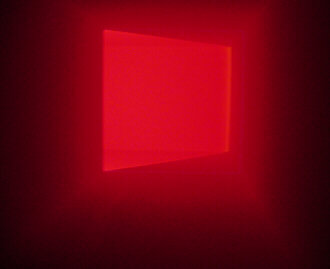In addition to embodying the "truth of light," Turrell's work is like a map of the contemplative process. First, his work usually entails a distancing between the mundane world and the place of the art: entering the sky spaces, being rolled into Gasworks, walking blindly into dark rooms with only one spot of projected light. Second, as this transition is completed, one must quiet down the mind and pay attention in order to perceive the art/light; to chitchat in a skyspace is not to experience it. Turrell himself describes the scientific operation of this process in terms reminiscent of Aldous Huxley. For Huxley, the essential truth of contemplative practice (and psychedelics) is that it is subtractive, not additive. The contemplative is not filling his/her mind with doctrine or suggestion; she is removing distraction and allowing reality as it is to be more clearly perceived.
 Pleiades is a work which exemplifies the Tao of Turrell. The viewer encounters
Pleiades by walking up a gentle incline for about six meters, into total darkness.
Whether one is in a tiny room or a vast space is impossible to tell except by guessing
at echoes. As a note outside the work explains, after about fifteen minutes
the visitor's eyes adjust to the darkness. These fifteen minutes are functionally
equivalent to insight meditation: as she watches the process of perception itself,
the visitor becomes acutely, directly aware of visual noise that she didn't even know
was there. After-images dance in the black space, arising and disappearing.
Slowly, a dim, red shape begins to appear, at first indistinguishable from the
perceptual 'interference.' The faintly glowing light is barely perceptible at first,
amid the noise, but gradually the noise dies down. After a half hour or so,
there is only the red light, resting silently in a field of blackness:
the inner light embodied.
Pleiades is a work which exemplifies the Tao of Turrell. The viewer encounters
Pleiades by walking up a gentle incline for about six meters, into total darkness.
Whether one is in a tiny room or a vast space is impossible to tell except by guessing
at echoes. As a note outside the work explains, after about fifteen minutes
the visitor's eyes adjust to the darkness. These fifteen minutes are functionally
equivalent to insight meditation: as she watches the process of perception itself,
the visitor becomes acutely, directly aware of visual noise that she didn't even know
was there. After-images dance in the black space, arising and disappearing.
Slowly, a dim, red shape begins to appear, at first indistinguishable from the
perceptual 'interference.' The faintly glowing light is barely perceptible at first,
amid the noise, but gradually the noise dies down. After a half hour or so,
there is only the red light, resting silently in a field of blackness:
the inner light embodied.
Is Pleiades "about" the science of perception, or the art of meditation? Both. Pleiades, Space that Sees, and similar works are attention practices. We shift from engaging our conceptual, symbolic minds to noticing the apparatus of Mind itself. While the theory behind the art is scientifically grounded -- saving Turrell from the muddy thinking that often hides under the adjective 'spiritual' -- in the experience of the artwork itself, we are not thinking about perception so much as noticing it take place. The bringing together of shamayim and aretz takes place in and through the reconfigured mind, newly aware of its perceptual apparatus and newly quiet in its operation.
So this is why they like Turrell: he is inviting us into an altered state
of consciousness and creating conditions that enable it. Obviously, it doesn't
always work. Sometimes the audience is busy chattering,
and fails to make room for the art to take place in the mind.
Some artworks resonate more than others. And there are some people
for whom suspending the conventions of consciousness is either too
frightening or merely too unpleasant.



Zeek in Print
Buy your copy today
Germanophobia
Michael Shurkin
The Red-Green
Alliance
Dave Hyde
The Art of
Enlightenment
Jay Michaelson
yom kippur
Sara Seinberg
Josh Plays the Sitar
Josh Ring
Genuine Authentic
Gangsta Flava
dan friedman
saddies
David Stromberg
about zeek
archive
links